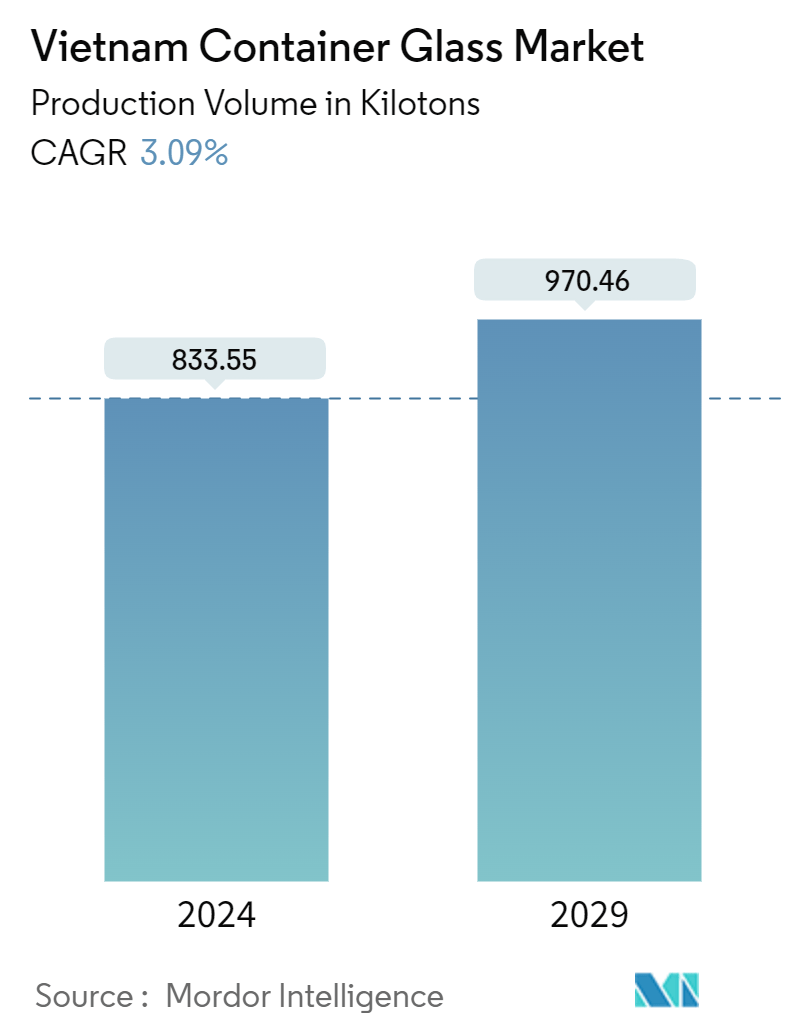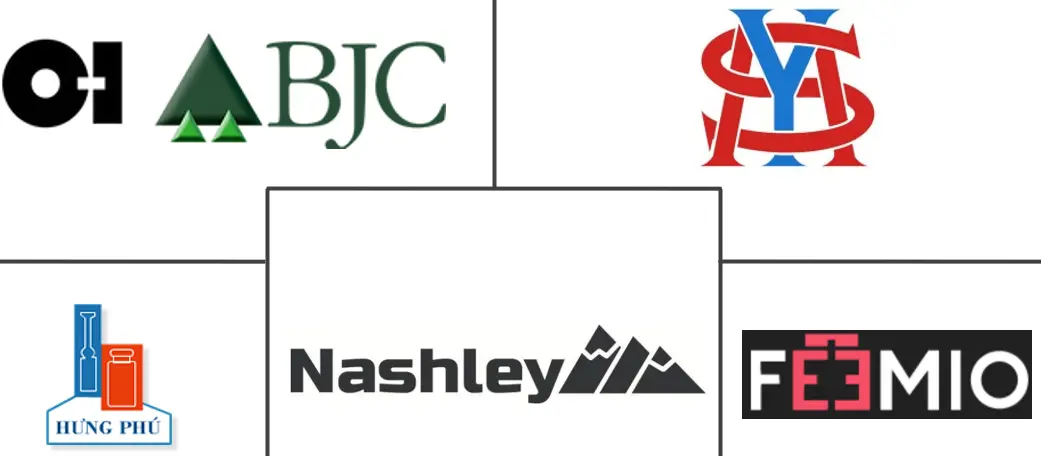Market Size of Vietnam Container Glass Industry

| Study Period | 2019 - 2029 |
| Base Year For Estimation | 2023 |
| Market Volume (2024) | 833.55 kilotons |
| Market Volume (2029) | 970.46 kilotons |
| CAGR (2024 - 2029) | 3.09 % |
| Market Concentration | Medium |
Major Players
*Disclaimer: Major Players sorted in no particular order |
Vietnam Container Glass Market Analysis
The Vietnam Container Glass Market size in terms of production volume is expected to grow from 833.55 kilotons in 2024 to 970.46 kilotons by 2029, at a CAGR of 3.09% during the forecast period (2024-2029).
- Vietnam's increasing urbanization spurs a growing appetite for diverse food and beverages. The country's inclination towards dining out and favouring convenience foods is eclipsing its traditional emphasis on home-cooked meals and grocery shopping. This transition is chiefly propelled by factors such as the swift growth of the middle class and the country's predominantly youthful population. With convenience stores, coffee shops, snack outlets, and the more comprehensive retail and hospitality landscape thriving, the demand for glass bottle packaging is poised for a significant upswing.
- The country's increasing consumption of food and beverages is the primary driver behind the significant demand for various packaging modes, notably glass bottles. The rising consumption of food and beverages in the country has directly influenced the growth of the retail industry, presenting a lucrative opportunity for glass bottle manufacturers to view Vietnam as a significant market in Southeast Asia. For instance, according to the General Statistics Office of Vietnam, the country's food and beverage consumption was VND 1,027 trillion (USD 42.11 billion) in 2022, and it is increased to VND 1,123 trillion (USD 46.04 billion) by 2023.
- Furthermore, the rising consumer preferences for safe and eco-friendly packaging are propelling the growth of glass packaging across various segments in Vietnam. Additionally, technological advancements, including embossing, shaping, and artistic finishes, enhance the appeal of glass packaging.
- Notably, the escalating demand for eco-friendly solutions and a surging appetite from the food and beverage sector are further fueling Vietnam's glass packaging market. The market is also benefiting from increased investments in research and development, which are driving innovations in glass packaging.
- However, the rise of alternative packaging options, including plastic, aluminum, and flexible materials, is hindering market growth. These alternatives tend to be more cost-effective, lighter, and easier to transport, appealing to both manufacturers and consumers. Further Additionally more, advancements in materials, such as recyclable plastics and biodegradable packaging, are diminishing the demand for conventional glass containers.
Vietnam Container Glass Industry Segmentation
The market is defined in terms of consumption sales of various container glasses such as bottles, jars, vials, and ampoules offered by various vendors operating in the market. The consumption volume (kilo tonnes) of the Vietnam container glass market is considered for the market size and forecasts. The market study factors are based on the prevalent base scenarios, key themes, and end-user vertical-related demand cycles.
The Vietnam container glass market is segmented by end-user industry (beverages (alcoholic (beer and cider, wine and spirits, and other alcoholic beverages), non-alcoholic (carbonated soft drinks, milk, water and other non-alcoholic beverages (juices, among others)), food, cosmetics, pharmaceuticals, other end-user industry). The Market Sizes and Forecasts are Provided in Terms of Volume (Tons) for all the Above Segments.
| By End-user Industry | ||||||||||||
| ||||||||||||
| Food | ||||||||||||
| Cosmetics | ||||||||||||
| Pharmaceuticals | ||||||||||||
| Other End-user Industries |
Vietnam Container Glass Market Size Summary
The Vietnam container glass market is experiencing a notable expansion, driven by a growing consumer preference for safe and eco-friendly packaging solutions. This trend is particularly evident in the food and beverage sector, where glass packaging is favored for its ability to preserve taste and quality. The market's growth is further supported by technological advancements in glass packaging, such as embossing and artistic finishes, which enhance its appeal. The increasing awareness of environmental impacts and the recyclability of glass compared to plastics are significant factors contributing to the rising demand for container glass. This shift is also influenced by the country's expanding middle class and youthful population, which are boosting the retail and hospitality sectors, thereby increasing the demand for glass bottle packaging.
The market is characterized by a fragmented landscape with several key players, including O-I BJC Vietnam Glass Co., Go Vap Glass, and Nashley Technology Joint Stock Company, among others. These companies are investing in innovation and sustainability to maintain a competitive edge. The premium segment, often packaged in glass, is expected to see continued growth, particularly in the wine and spirits market, as consumers increasingly seek high-quality and environmentally friendly products. Additionally, potential government regulations aimed at reducing plastic usage could further enhance the demand for glass packaging. The market's expansion is also reflected in the increased retail sales of alcoholic beverages, which are likely to drive further investments in glass packaging solutions.
Vietnam Container Glass Market Size - Table of Contents
-
1. MARKET INSIGHTS
-
1.1 Market Overview
-
1.2 Industry Attractiveness - Porter's Five Forces Analysis
-
1.2.1 Bargaining Power of Suppliers
-
1.2.2 Bargaining Power of Consumers
-
1.2.3 Threat of New Entrants
-
1.2.4 Intensity of Competitive Rivalry
-
1.2.5 Threat of Substitute Products
-
-
1.3 Industry Ecosystem Analysis with Emphasis on Circular Economy
-
1.4 Industry Standards and Regulations for Glass Packaging in Vietnam
-
1.5 Raw Material Price Trend Analysis Cullet, Sand, and Container Glass
-
1.6 Trade Analysis
-
1.7 Vietnam Container Glass Industry
-
-
2. MARKET SEGMENTATION
-
2.1 By End-user Industry
-
2.1.1 Beverage
-
2.1.1.1 Alcoholic
-
2.1.1.1.1 Beer and Cider
-
2.1.1.1.2 Wine and Spirits
-
2.1.1.1.3 Other Alcoholic Beverages
-
-
2.1.1.2 Non-Alcoholic
-
2.1.1.2.1 Carbonated Soft Drinks
-
2.1.1.2.2 Milk
-
2.1.1.2.3 Water and Other Non-alcoholic Beverages (Juices, Among others)
-
-
-
2.1.2 Food
-
2.1.3 Cosmetics
-
2.1.4 Pharmaceuticals
-
2.1.5 Other End-user Industries
-
-
Vietnam Container Glass Market Size FAQs
How big is the Vietnam Container Glass Market?
The Vietnam Container Glass Market size is expected to reach 833.55 kilotons in 2024 and grow at a CAGR of 3.09% to reach 970.46 kilotons by 2029.
What is the current Vietnam Container Glass Market size?
In 2024, the Vietnam Container Glass Market size is expected to reach 833.55 kilotons.

